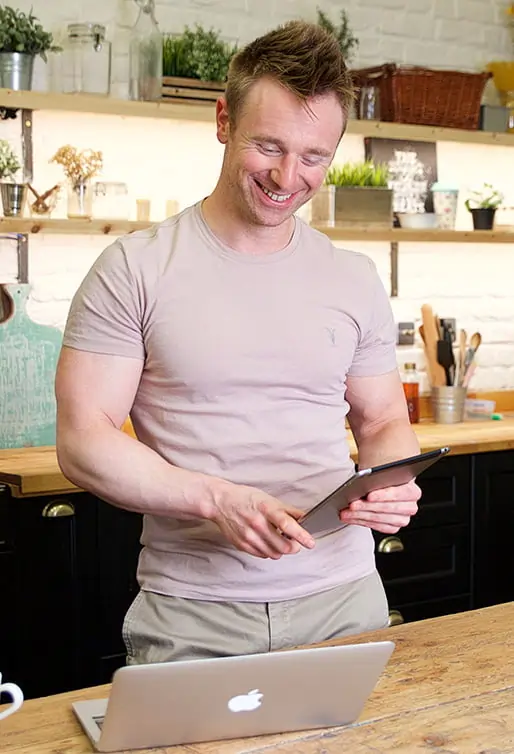
When trying to achieve impressive results in fitness, it’s going to come down to two things, following the right workout plan and staying consistent with it. The first is pretty easy to solve with a good deal of research or having a personal trainer build a program for you, I’ve actually written a guide to help you make sure a workout plan will be effective. Many people struggle to establish a consistent exercise habit, which is a shame because even the best laid-out workout program isn’t going to work if it’s abandoned early.
Why is consistency important?
Although you might think that there’s no harm in taking a stop/start approach to fitness. Perhaps because sometimes you’re just more focused on fitness than at others which would naturally imply different levels of activity at different times.
I would caution against that approach because inactivity doesn’t just represent maintenance, you can’t put your body into stasis. Due to the law of entropy, if you stop exercising, you will begin to lose ground on where you are, it’s just how conditioning, indeed nature works. It’s essentially the ‘use it or lose it’ concept.
But perhaps more insidious than that, each time we fail to follow through on a training plan, we run the risk of weakening our motivation, willpower and self-esteem. Repeated internal references for failure can dent our self-image and make us more hesitant to take on challenges in the future, that might otherwise contribute to maximising our potential. To compound that, failed attempts at exercise mean more lost ground on our original starting position, which can lead to subsequent attempts being more extreme and as a result less likely to succeed.
But of course, there is another side to all this. Self-esteem and a positive self-image aren’t built on our huge life achievements, they come from keeping appointments with ourselves on a frequent basis. Essentially if you want to become more confident, the best way to do it is to follow through on doing the things we say we’re going to do. Either to other people or ourselves. In essence, establishing a frequent exercise habit is not only great for your health, but it’s also an excellent springboard for change in other areas of your life.
What is a habit?
Before we set out to establish exercise as a regular habit, let’s define exactly what we mean by the word. The dictionary definition is:
“a settled or regular tendency or practice, especially one that is hard to give up”.
So that really sums up what we’re trying to achieve. Not only is a habit well established, but it’s actually so well ingrained and rewarding that it’s HARD to give up. Think about that, so many people struggle to make exercise stick, and others would actually feel more uncomfortable not exercising on a given day than doing it. How can we go from the former to the latter?
Well to implement a new habit, it’s best not simply to rely on willpower, as that can amount to a bit of a whim. I believe it helps to understand the mechanics of this. Most people don’t fully understand the mechanics of how a habit is established, so let’s examine the three core components of a habit:
The Cue or Trigger
This is the part of the habit loop where you are triggered to take some sort of action through a cue in your internal or external environment.
The Action
Good or bad, this is the part of the habit loop where you actually take action on the habit you want to adopt or drop
The Reward
This is the part of the habit loop where your brain receives a reward for taking the desired activity (or not, as you will see in just a second).
Let’s examine how to put this together through the frame of reference of fitness…
Another challenge you might face with establishing a habit is trying to take on too much at once, or having an unrealistic expected time frame for what you’d like to achieve.
Ultimately, you have to broker a deal, with yourself. If you are trying to get into regular exercise. It might be to your advantage to select forms of exercise that you either enjoy or have a low logistical barrier to entry. For example, let’s say you want to lose weight, and you also hate swimming, there is no point in starting your fitness journey in a pool. The goal could be achieved with any number of other types of training, so choosing swimming although it would technically work, would cause unnecessary friction.
Likewise, if you are looking to cultivate a winning mindset for fitness that will keep you consistent in good times and bad, there is no point starting out with tennis for example. Where by definition, you would be reliant on someone else to play with to get started, you’re introducing too many moving parts, so there would be too many opportunities for an uncontrollable variable to let you down i.e. your tennis partner doesn’t turn up.
It’s also worth considering the role motivation plays in implementing these habits. Having said that, the power of motivation, in practice, is significantly overestimated and seldom fully understood. Everyone has motivation in theory, in that everyone wants something, but few develop the kind of burning desire that makes their motivation a reality.
To achieve this, try visualising exactly what establishing this habit would mean for you. How getting consistent with exercise would contribute to your broader goals. And the impact it would have on your life in general. And I mean literally visualise yourself on the other side of your current goals. Which might mean looking a certain way, feeling a certain way being able to do certain activities for longer, or whatever the goal means to you.
Sit with these emotions, lock them into your memory, visit them regularly and build a solid association between these emotions and the habit you’re aiming to establish. This is a Neuro-linguistic programming technique known as ‘anchoring an emotion‘ and on dark, rainy days, revisiting these emotions will be far more powerful than what we broadly refer to as motivation or ‘will-power’
How to make exercise a habit
I’d recommend two simple options to kick things off and start making exercise a habit. The first is simply to get out of the house and walk for ten minutes each day and the second is to follow a simple mobility practice indoors each day. Let’s look at how the mechanics of a habit can be applied to these examples:

Stage 1: This is your cue or trigger, so the easiest thing to do here would be to leave your exercise shoes by the door for the walk or your exercise mat laid out ready for the morning mobility practice (try mine here). This is what you call ‘priming your environment’ and it stacks the odds in your favor.
Stage 2: This is the action. In our scenario this means as soon as you see your shoes, you put them on and get right out the door before you have time to rationalise yourself out of it. For the mobility example, you get down on the mat and start moving through your sequence.
Stage 3: The last stage is the reward stage. This can be both internal and external -remember what we said about building self-esteem, the very act of seeing your activity through is going to be internally rewarding. Let’s also call back to what we said about brokering a deal with yourself, rewarding yourself with a great warm drink like a tea or coffee once you’re finished with your activity would work really well as an external reward.
It’s worth noting that I’ve set both of these actions for first thing in the morning. I’ve often found in my experience as a personal trainer that scheduling your exercise early on in the day often means a lower chance of some unforeseen circumstances arising and making the activity harder to carry out.
To bolster the Cue, Action, Reward method we’ve just outlined let’s introduce the psychological principle of ‘Implementation Intentions’. Implementation intentions present a self-regulatory strategy that can help increase your chances of successful goal achievement.
In his excellent book Atomic Habits, James Clear outlines a poignant example and showcases what we’ve been discussing.
Researchers in Great Britain segmented a sample of people who had all signalled that they were ‘motivated’ to exercise regularly.
248 people were segmented into three groups. Group one was the control group. And were simply asked to track how often they exercised.
Group two were termed the ‘motivation’ group, and were asked not only to track their workouts but also to read some material on the benefits of exercise.
Finally, there was the third group. These subjects were given the same motivational and educational material as the second group, which ensured that they had equal levels of motivation. However, they were also asked to formulate a plan for when and where they would exercise over the following week.
Specifically, each member of the third group completed the following sentence:
“During the next week, I will partake in at least 20 minutes of vigorous exercise on [DAY] at [TIME] in [PLACE].”
At the end of the study, they found that 35% to 38% of people in the first two groups exercised at least once per week, but 91% of the third group exercised at least once per week—more than double the normal rate.
Therefore the study suggests that by simply writing down a plan that said exactly when and where they intended to exercise, the participants in Group 3 were much more likely to actually follow through.
To apply this strategy to the habits suggested above, our Implementation Intention will be as follows:
“I intend to go for a ten-minute walk around my area every morning, as soon as I wake up”
Although in the early stages of a habit, we’re negotiating with ourselves to get something done on a regular basis, it becomes easier to do over time as the habit beds in. Eventually, it will be just as routine as brushing your teeth or taking a shower. At this point you’ll no longer have to broker a deal that is so heavily stacked in your favour and, if you wanted to, you’d be able to make a habit out of much less pleasant activities, such as a freezing cold shower for example.
Over time, productive habits will shift your identity, develop character and just like negative habits, have the power to shape our lives. Now that you know how habits work, you have the power to establish any healthy habits you want for yourself.
“Intention is more than wishful thinking, it’s willful direction” – Jennifer Williamson
If you would like to discuss how working with me as your online personal trainer might help you create the right habit set to help you achieve your health & fitness goals, schedule a consultation call and we’ll discuss the correct strategy you can implement to achieve your goals.